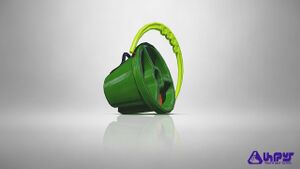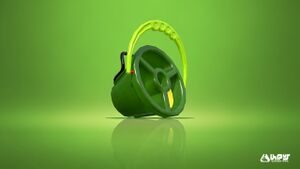Competitive:Tri-Slosher
- For information about the Tri-Slosher, see Tri-Slosher.
Splatoon
| Abbreviations | Tri, Tri-Slosher, Slosher, Bucket |
| Sub | |
| Special | |
| Base damage | 62 |
| Ink consumption | 6% |
| Special depletion |
Gear abilities
Gear abilities provide different effects in battle that benefit the player with their equipped weapon. This is a guide to gear abilities in relation to the weapon. Strategy, synergy, viability, and purpose may be written here.
Splatoon 2
| Abbreviations | Tri, Tri-Slosher, Slosher, Bucket |
| Sub | |
| Special | |
| Base damage | 62 |
| Ink consumption | 6% |
| Special points | 190p |
| Role | Slayer[1] |
| Strengths | Splatting, turfing, mobility, flexible with abilities |
| Weaknesses | Slower firing rate and worse ink efficiency than most shooters and dualies |
Use
The traits of the Tri-Slosher make it a quintessential slayer's weapon:
- Its high damage (62 health points, or HP, per hit), relatively quick rate of fire for a slosher-class weapon (12-16 frames for the first shot, 24 frames between shots), and Burst Bombs all translate into quick two-shot splats, making it deadly in both flanking and sharking.
- Its range is comparable to that of the Splattershot and the N-ZAP '85 (88 units). This range, combined with its wide shot spread, makes it difficult for shorter ranged weapons – particularly brushes and most rollers – to safely approach an opposing Tri-Slosher.
- The Tri-Slosher's lightweight nature and Burst Bombs give it more inherent mobility than many other slayer's weapons, allowing its user to either pursue opponents or escape unfavorable matchups more easily.
- Both the main weapon's wide shots and its Burst Bombs enable their user to rapidly turf large areas to either gain or maintain map control and quickly either capture or contest zones in Splat Zones.
- The arc-like trajectory of the Tri-Slosher's shots has a couple unique applications:
- Shots can be fired up a ledge or incline more easily than a shooter's shots can, making it valuable for pushing up slopes or walls.
- Shots can also be launched over some obstacles, hitting opponents who may hide behind them.
- While quick at both splatting and turfing, the Tri-Slosher does have two weaknesses:
- Like other slosher-class weapons, its rate of fire is slower than that of most shooters. While both the Tri-Slosher and the Splattershot have similar ranges, the Splattershot has a quicker splatting time (35 damage, 3-11 frames for the first shot, 6 frames between shots, totaling 15-23 frames to reach 100 HP damage) than the Tri-Slosher (36-40 frames); even the N-ZAP '85 has a quicker splatting time (28 damage, 3-11 frames for the first shot, 5 frames between shots, totaling 18-26 frames) than the Tri-Slosher.
- The Tri-Slosher consumes ink more quickly than most shooters. Aimlessly flailing it around will rapidly deplete the ink tank, leaving its user very vulnerable.
The instant explosion and good ink efficiency of Burst Bombs offer a Tri-Slosher user plenty of uses:
- The quick explosion of ink will instantly turf inkable surfaces, permitting either a fast pursuit of an opponent or a rapid retreat from an unfavorable situation.
- Their quick damage makes them suitable for either leading off attacks or finishing off injured opponents who attempt to flee.
- Opponents hit by Burst Bombs will be surrounded by your team's ink, further crippling their health and mobility.
- Direct hits will inflict 60 HP of damage, while splash damage will only deliver 25-35 HP. Always go for direct hits whenever possible.
While the Tri-Slosher's role as a slayer does not permit its Ink Armor to be depended upon as much as that from a Support weapon, whenever available, it still allows its user's team to either initiate a push, to recapture a Splat Zone, for example, or maintain one, such as while locking out the opponent.
- Time the activation of Ink Armor carefully before engaging the opponent; it takes up to two seconds to activate it, while it lasts for at least six seconds.
- Try to activate the Ink Armor when most or all teammates are active. Slayers (including a Tri-Slosher user), who risk getting splatted more often than Anchors, benefit from Ink Armor more.
- Upon activation, Ink Armor will protect its user and their teammates except for those either carrying the Rainmaker or using either Baller or Booyah Bomb.
- Also, players protected by Ink Armor lose it upon gaining possession of the Rainmaker.
- As a slayer, a Tri-Slosher user is not expected to carry the Rainmaker. Instead, they should engage any opposing defenders and turf a path of ink for the Rainmaker carrier to quickly travel along. Therefore, while Ink Armor will not protect the Rainmaker carrier, it will still benefit their teammates, so cast Ink Armor just before engaging the opposing team.
Synergy
Multiple Ink Armors used by the same team do not stack. Therefore, it would be redundant for a team to have more than two Ink Armor users.
- In general, when two Ink Armor-based weapons are on a team, the user of the more aggressive weapon should activate Ink Armor first, freeing them to engage the opponent without potentially losing both a potential Ink Armor and special gauge progress. Therefore, the Tri-Slosher user should generally be the first to activate Ink Armor, while their more supportive teammate should activate their Ink Armor as the first one wears off.
Countermeasures
- Matchups between Tri-Sloshers on opposing teams are determined by each player's skill, positioning, turf control, and the presence of any teammates.
- Any weapon that has a combination of longer range, better accuracy, or higher damage output without sacrificing too much mobility can counter a Tri-Slosher. For example, both the Splattershot Pro and Dualie Squelchers and their respective variants meet all of these requirements. However, beware of any Burst Bombs the opposing Tri-Slosher wielder might throw.
- The wielder of a shorter ranged, quicker firing weapon should flank, shark, or outmaneuver (e.g. via dodge rolling) the Tri-Slosher to exploit its slower firing rate.
- A long-ranged weapon, such as a charger or most splatlings, can attack a Tri-Slosher from long distance with impunity. However, once the Tri-Slosher gets close, the tables are turned, as it can outmaneuver and outdraw its less mobile, slower firing opponent.
- A competent Tri-Slosher user is likely capable at both flanking and sharking:
- Keep track of all four members of the opposing team – which ones are present, which ones are splatted, and which ones are back at their spawn point.
- Check the map periodically for opposing ink forming around flanks to anticipate a flanking attack.
- To prevent sharking, check suspicious puddles of the opponents' ink, preferably with a thrown sub weapon.
- Weapons that track opponents, such as Point Sensors, temporarily prevent an opponent from sharking and makes them an easier target for long-ranged teammates to pick off.
- When pursued by a Tri-Slosher, using almost any sub weapon (except for Squid Beakons) can either delay their pursuit or deter them from chasing.
- Keep an eye on the HUD to know when the opponent's Tri-Slosher has Ink Armor ready to use, and both watch and listen for when it is activated.
- The best way to prevent the opponent from using armor is to splat the opponent with the Tri-Slosher (or any other Ink Armor-equipped weapon). A charger user can prioritize said opponent when sniping, or a slayer can attempt to pick off a lone Tri-Slosher
- Focus fire on armored opponents for longer than usual - preferably with everyone ganging up on one opponent at a time - to compensate for their armor.
- Object Shredder triples damage inflicted onto armored opponents. Combining this with Ink Storm can nearly neutralize armored pushes by the opponent.
Gear abilities
Gear abilities provide different effects in battle that benefit the player with their equipped weapon. This is a guide to gear abilities in relation to the weapon. Strategy, synergy, viability, and purpose may be written here.
Unless a Tri-Slosher wielder is on an extended splatting streak, they can expect to get splatted often. When equipped, Comeback grants 10 ability points of six different stackable abilities for twenty seconds after respawning from getting splatted by an opponent:
The former three abilities are particularly useful for the Tri-Slosher, allowing it to consume less ink and maintain pressure on the opponent upon returning from spawn.
Quick Respawn shortens respawn time after getting splatted (under specific conditions), encouraging the Tri-Slosher to remain aggressive even after getting splatted.
- 26 ability points – two mains and two subs – are enough to reduce the respawn time from 8.5 seconds to 5.8 seconds.[2]
Super Jumping to a teammate after respawning carries the risk of getting splatted upon landing, due to the appearance of a Super Jump indicator. When equipped, Stealth Jump better covers this indicator from long distance opponents, allowing its user to more safely return to the front lines and maintain pressure on the opponent. [3]
References
|



